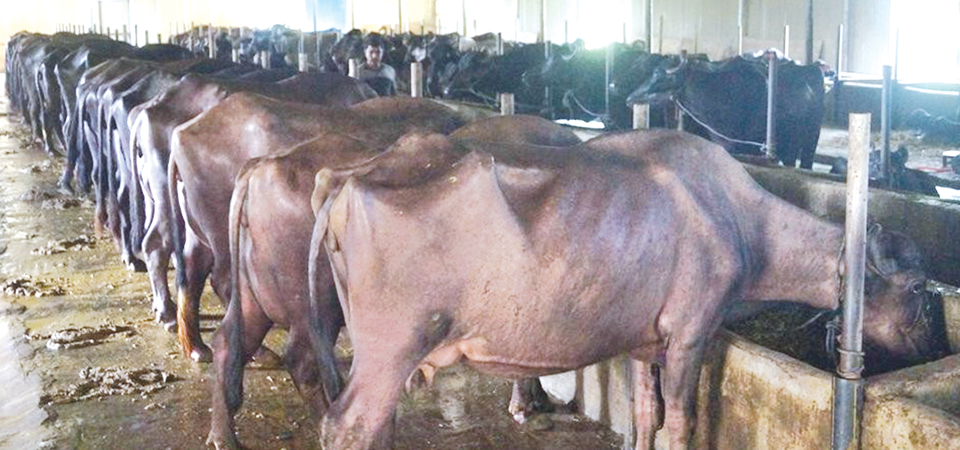Country on the path of dairy self-reliance

By Modnath Dhakal
Pokhara, Mar. 13: Disturbances in supply of milk during the COVID-19 pandemic has resulted in 1,500 tons of skimmed milk powder production which is 3.5 times higher compared to the previous year. Total milk conversion to powder in Fiscal Year 2019/20 was about 11.5 million litres which was just 3.25 million litres in 2018/19 and 2.25 litres in 2017/18.
Milk collected by the dairy industries was sent to Sujal Dairy in Pokhara and Chitwan Milk in Chitwan to convert into powder.
“Nearly 1100 tons is in stock due to COVID-19. Dairy industries couldn’t sell the milk as in the normal times but they keep on procuring milk continuously and produced powder milk,” said Arniko Rajbhandary, Immediate Past President of Dairy Industries Association (DIA) at the organisation’s 13th Annual General Assembly held on Friday in Pokhara.
The amount of powder milk is enough to meet the demand for the current fiscal year 2020/21.
Total skimmed milk powder requirement in Nepal is 3,200 tonnes per annum and total production (in 2019/20) was 2,600 tonnes.
According to Rajbhandary, Nepal is on the path to become self-reliant in dairy products.
The share of dairy imports in 2015/16 was Rs. 12.51 billion in total agricultural imports of Rs. 150 billon. The imports came down to Rs. 2.2 billion in 2019/20 while the total agricultural imports stands at Rs. 220 billion.
Dairy entrepreneurs said that the growing informal dairy processing and distribution businesses had created risk to the quality and size of the production.
“We can’t compete with the informal businesses as they don’t pay the taxes,” they said.
Almost 50 per cent milk production is consumed domestically, only 20 per cent is processed by formal dairy industries rest is processed and distributed informally, said Raj Kumar Dahal, chairman of DIA.
They want more incentives to the dairy industries for the quality production and import substitution.
Likewise, incentives and innovative programmes are required for the farmers as well. Average milk production per cow in the European countries and the United States of America is about 9,000 litres per year while Nepali cows produce just about 725 litres a year.
“The government must run intervention programmes and announce incentives to support in increasing the production of milk,” said Rajbhandary. Dairy industry sends about Rs. 12 billion to the rural areas.
Chairman Dahal said that although dairy is an important sector in agricultural industry, the government has not given priority to it and has not announced any facilities and incentives.
“This is the sector with transparent business activities and there had been no black- marketing of this perishable item not even during the difficult times,” he said.
According to dairy entrepreneurs, the industry has threats from uncontrolled unorganised sector, unfair competition among organised sector, and unequal distribution of grants and support. Likewise, open border, high cost of production and productivity and increasing foreign direct investment in neighbouring countries are other challenges.
Ganesh Bahadur Shrestha of Sujal Dairy said that the government must not establish and operate dairy and agricultural enterprises where private sector is doing well.
Minister for Land Management, Agriculture and Cooperative of Gandaki Province Lekh Bahadur Thapa Magar said industries should be able to make good payment to the farmers.
Grants and incentives to the agricultural and livestock sectors should be effective and result oriented, he maintained. “The federal government is bearing 75 per cent cost of agriculture and livestock insurance. The province is supporting farmers with the 25 per cent insurance cost thus making the insurance free of cost,” he said.
Director General of Dairy Development Board Dr. Rajendra Yadav said that the board was giving ambulance-level priority to the milk transportation vehicles. “We are using special logo in the vehicles in order to remove the hassles on the road,” he said.
Recent News

Do not make expressions casting dout on election: EC
14 Apr, 2022
CM Bhatta says may New Year 2079 BS inspire positive thinking
14 Apr, 2022
Three new cases, 44 recoveries in 24 hours
14 Apr, 2022
689 climbers of 84 teams so far acquire permits for climbing various peaks this spring season
14 Apr, 2022
How the rising cost of living crisis is impacting Nepal
14 Apr, 2022
US military confirms an interstellar meteor collided with Earth
14 Apr, 2022
Valneva Covid vaccine approved for use in UK
14 Apr, 2022
Chair Prachanda highlights need of unity among Maoist, Communist forces
14 Apr, 2022
Ranbir Kapoor and Alia Bhatt: Bollywood toasts star couple on wedding
14 Apr, 2022
President Bhandari confers decorations (Photo Feature)
14 Apr, 2022










